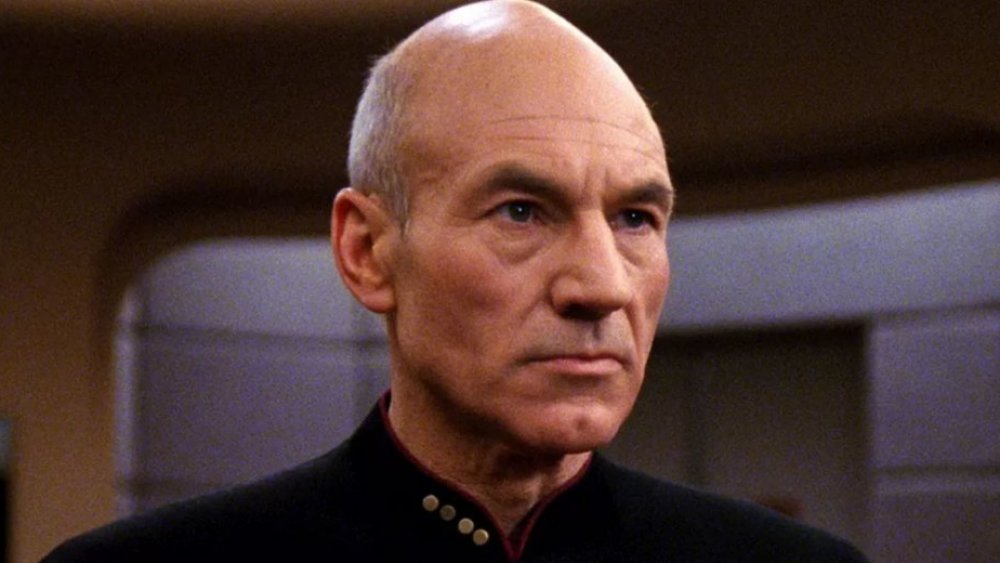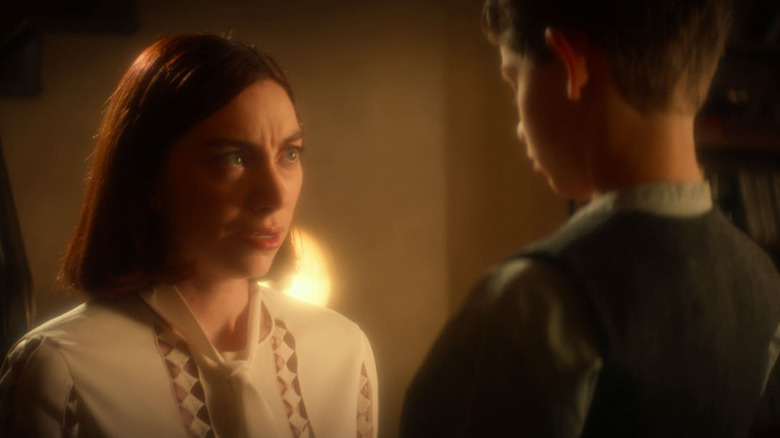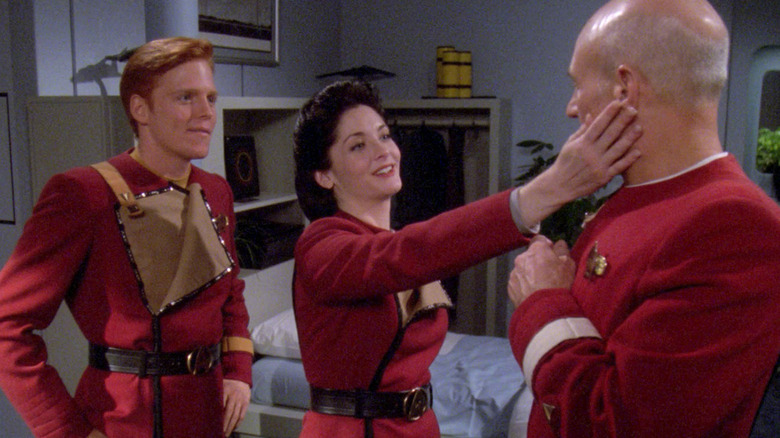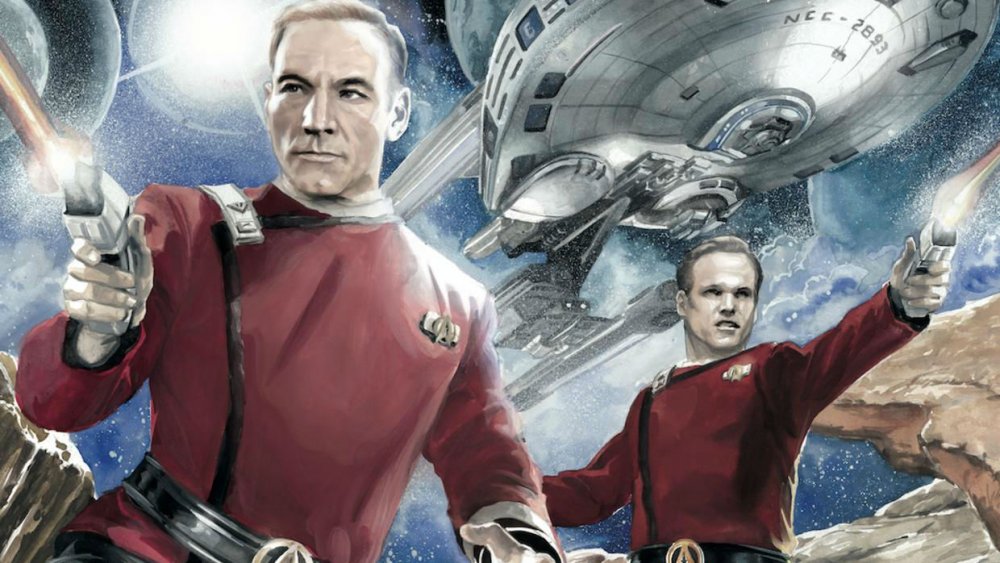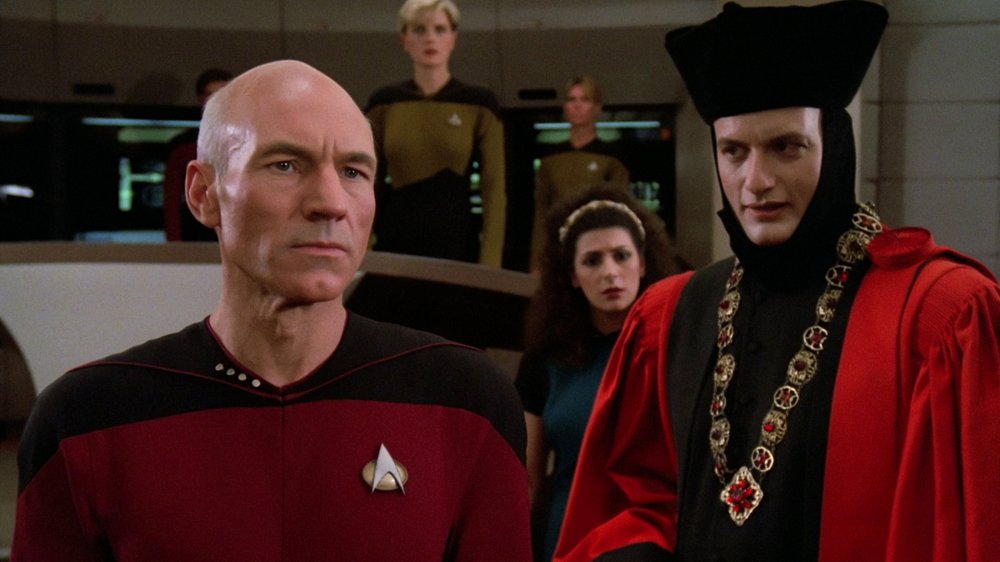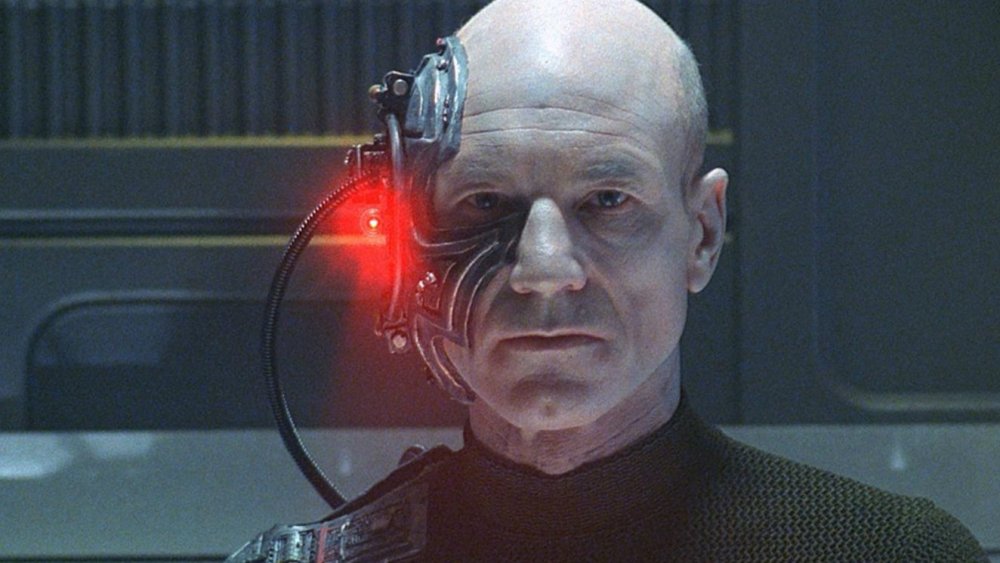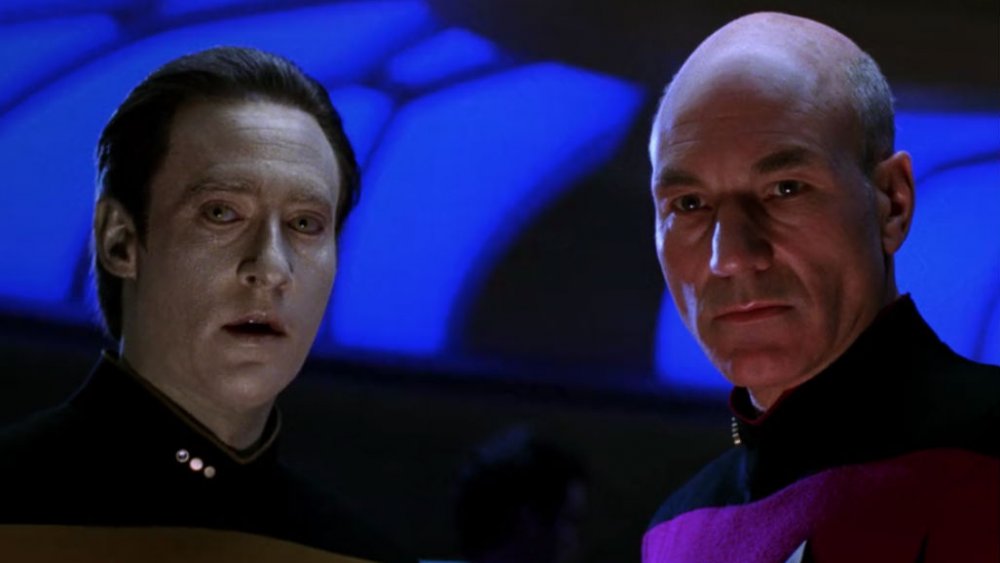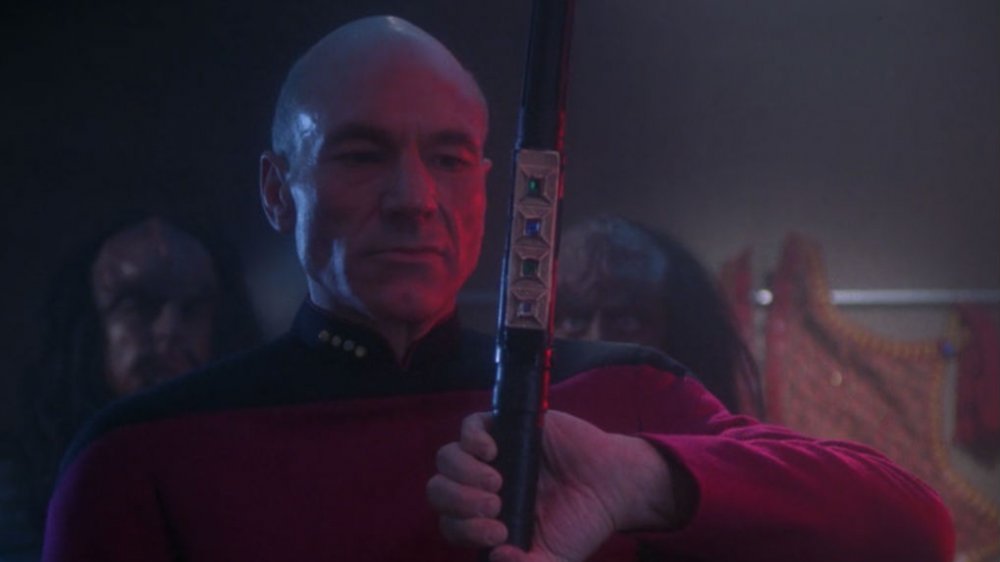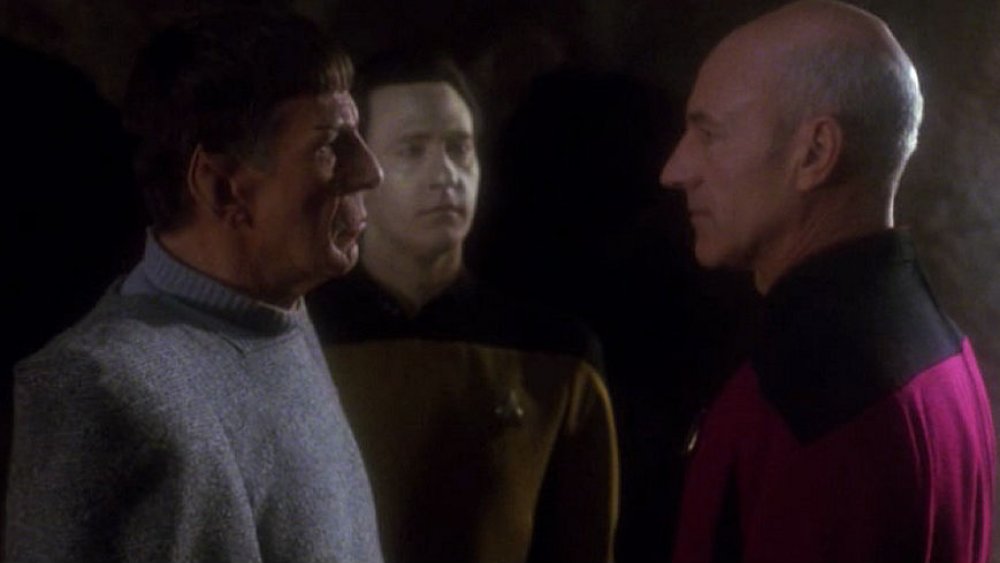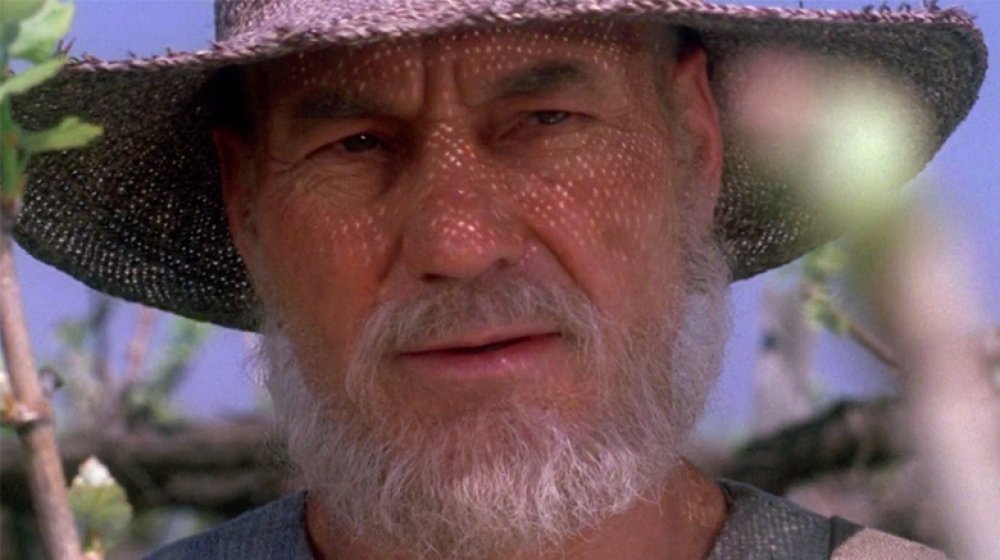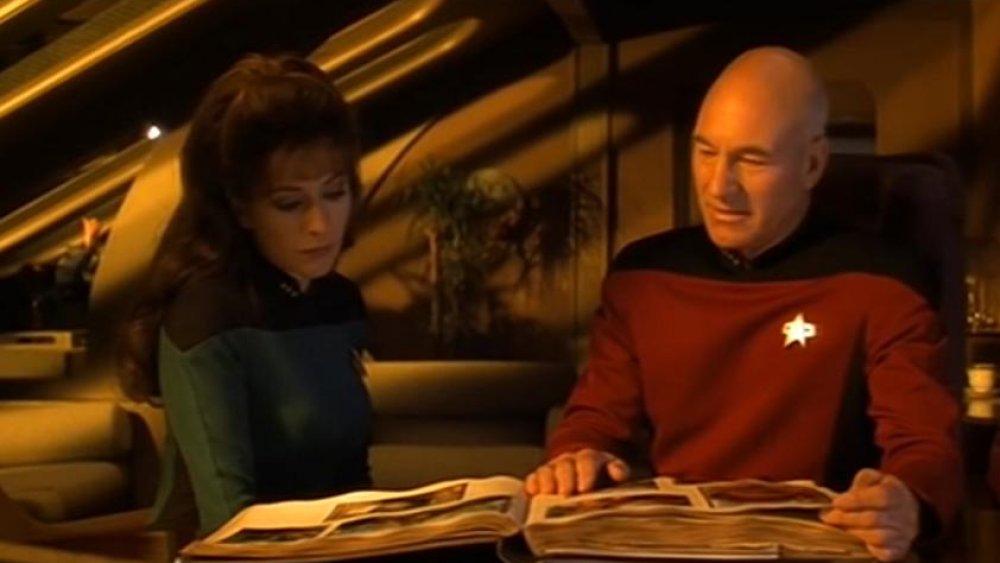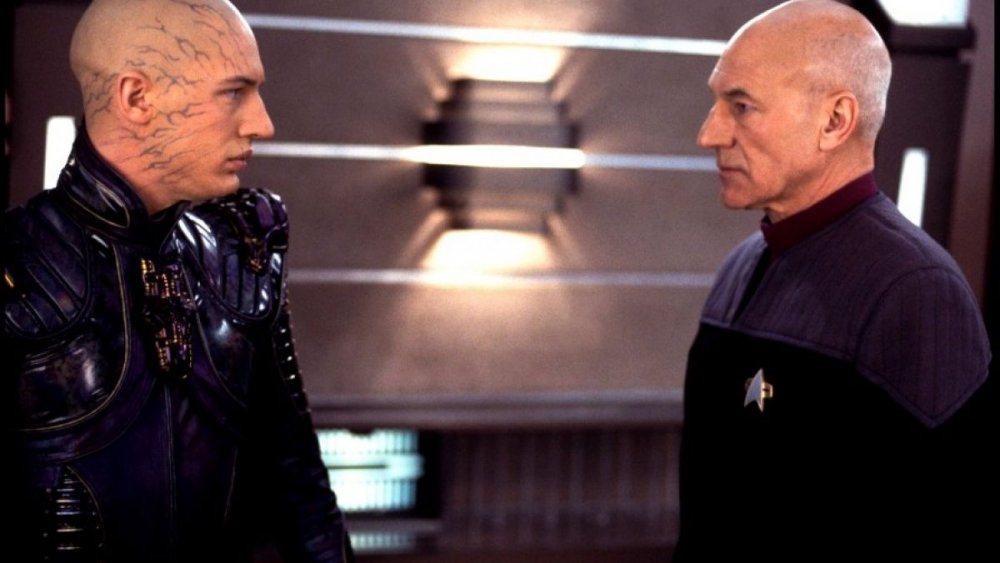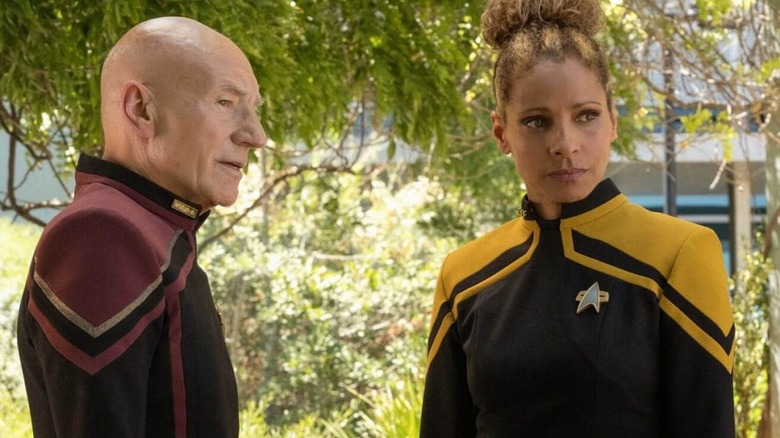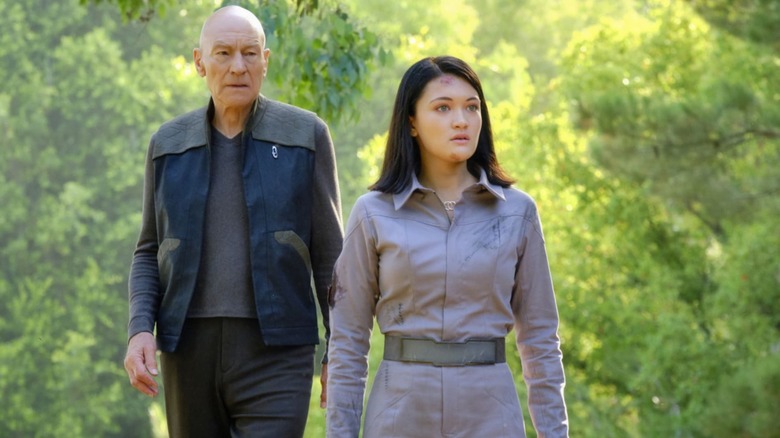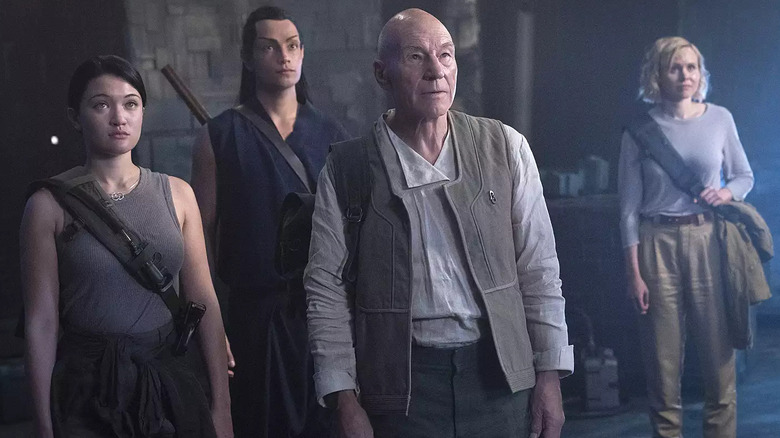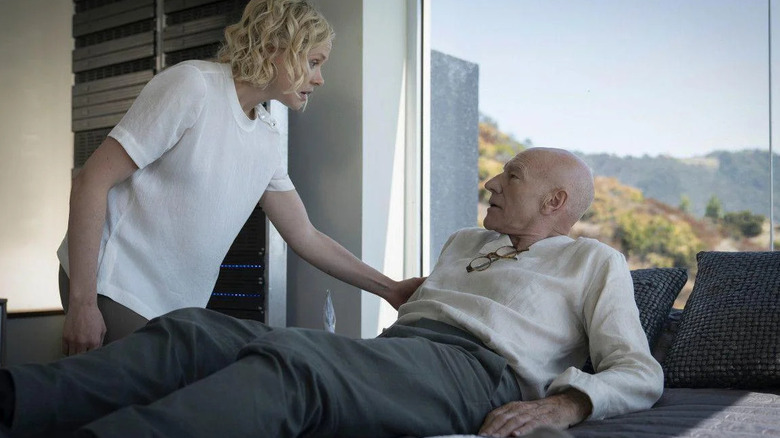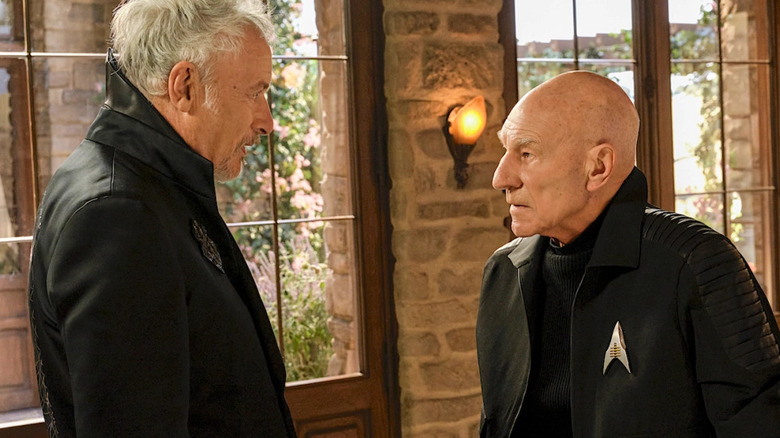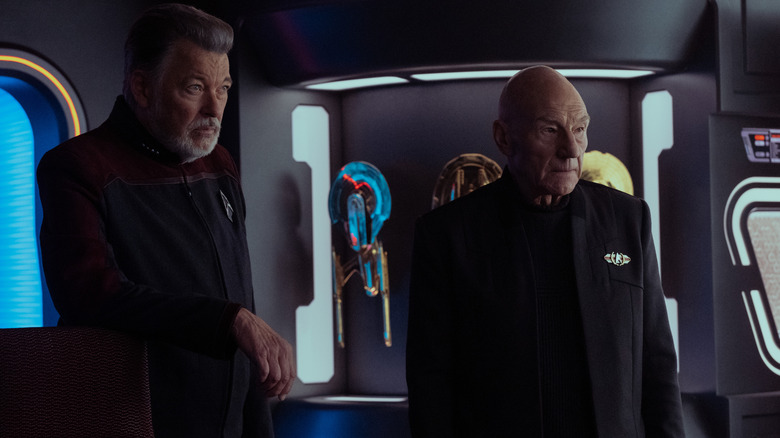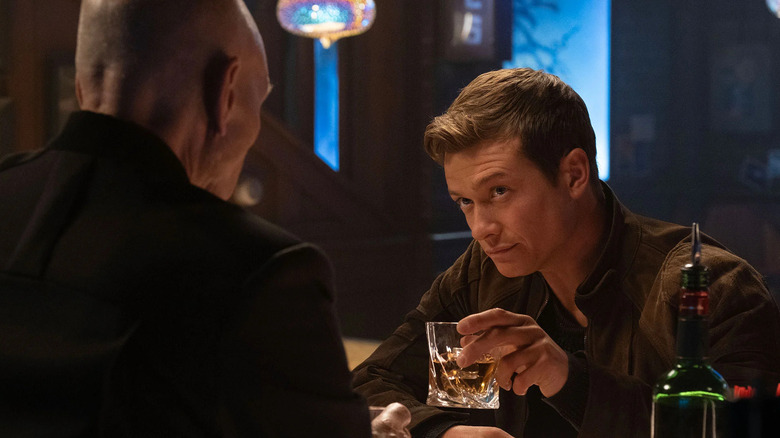Jean-Luc Picard's Entire Timeline Explained
From Jonathan Archer to Philippa Georgiou, "Star Trek" captains are the heroes who hold their crews together as they explore strange new worlds and boldly go where no man has gone before. But while the sci-fi franchise has seen some impressive leaders like Benjamin Sisko and Christopher Pike, Captain Jean-Luc Picard (Patrick Stewart) stands head and shoulders above the rest.
Introducing himself to fans as the captain of a newer, more advanced version of the iconic Enterprise in 1987's "Encounter at Farpoint" – the first episode of "Star Trek: The Next Generation" – Picard went on lead his crew into danger and glory for seven seasons and four major motion pictures. Compared to his predecessor, James T. Kirk of the original series, Picard was less of a ladies' man and nowhere near as trigger-happy. But that didn't mean he shied from adventure. In his time aboard the Enterprise, Picard struck bargains with interstellar gods, waged war on cyborg collectives, and altered the courses of alien empires forever. He made Earl Grey tea famous, he didn't like kids, and he regularly quoted the all-important Prime Directive (usually right before breaking it).
But if you haven't seen "The Next Generation (TNG)" and want to know more about the man, or if you just need a refresher on your "Star Trek" history, then read on as we explain Jean-Luc Picard's entire timeline.
A traumatic childhood
Born in La Barre, France, young Jean-Luc Picard had a troubled upbringing. The first glimpse of his childhood comes in the "TNG" episode titled "Family," where he visits his brother Robert on Earth. In this episode, we learn that Jean-Luc and Robert helped their father take care of the family's vineyards. We also learn that the rest of Jean-Luc's family are traditionalists, don't favor advanced technology like replicators, and certainly don't have a high opinion of the vaunted Starfleet. Meanwhile, his brother is something of a bully to him.
But we learn much more about the young Picard's early life in Season 2 of "Star Trek: Picard." Apparently, he had an especially close relationship with his mother Yvette. But Yvette suffers from severe mental illness, and despite her husband Maurice's pleas, she refuses to seek help. As a result, Maurice is often forced to lock her in her room to prevent her from self-harm during particularly difficult episodes, which leads to one of the most life-altering moments in Jean-Luc's life.
Amid one of his mother's episodes, she calls to Jean-Luc to let her out of her room. When he does, it ultimately leads his mother to ending her own life. Picard carries the guilt of this incident with him all of his life, only finally coming to terms with it as an older man.
If you or anyone you know is having suicidal thoughts, please call the National Suicide Prevention Lifeline by dialing 988 or by calling 1-800-273-TALK (8255).
Picard's academy days
Moving past tragedy, Jean-Luc's time on the family vineyard continues to frustrate him, as he has little interest in the family business of wine making. It doesn't take long for Jean-Luc to figure out that his path leads to the stars, and the future Enterprise captain soon gains a reputation as an overachiever, becoming a sports champion as well as valedictorian of his high school. Against his father's wishes, Jean-Luc leaves home for Starfleet Academy as soon as the opportunity arises, though it takes him two attempts before his application is accepted.
In Season 6's "Tapestry," we learn a little bit more about what kind of man he is during his Academy days. Far from the steady, stoic, commanding leader, Picard is a brash, fiery, cavalier sort, and even something of a womanizer while at Starfleet Academy. It's there that he meets both Jack Crusher and Beverly Howard, with the three becoming close friends. We also learned he had something of an unrequited crush on Academy mate Marta Batanides.
But we also witnessed an event just after his exit from the Academy that leaves its deepest mark on him. While waiting for his first assignments, Picard gets into a brawl with a group of Nausicaans over a game of dom-jot. Overmatched but refusing to back down, Picard is stabbed through the heart, and while he survives the injury, he's left with an artificial organ in his heart's place.
Picard's commands before the Enterprise
We don't know a lot of details about Picard's post-Academy life before he got command of his own ship. From the Season 2 episode "The Measure of a Man," we learn that at one point, he served on the USS Reliant, but we know few details about his time there. We know a bit more about his first command aboard the USS Stargazer. He started there as a bridge officer, but he made his way up the ranks the old-fashioned way – being the highest ranked officer left alive in the middle of a battle.
Jean-Luc commanded the Stargazer for two decades, until he and the surviving crew were forced to abandon the vessel after a battle with a Ferengi ship (though the Stargazer would be recovered years later in the Season 1 episode "The Battle"). Among some of the more relevant events in Starfleet history, the Stargazer saw action in the Federation's wars with Cardassia, and the ship's final battle led to the "Picard Maneuver" being coined for the unorthodox move Jean-Luc made to destroy the enemy vessel.
More personally relevant to Picard was his friendship with Jack Crusher aboard the Stargazer. Jack was the late husband of Beverly Crusher and father to Wesley, both of whom wind up serving aboard the Enterprise. It's Picard who, while commanding the Stargazer, sent Jack Crusher on an away mission that led to his death.
Jean-Luc Picard, captain of the Enterprise
There are some dark years between the loss of the Stargazer and Picard's command of the Enterprise. It seems clear Picard enjoyed command over at least one other ship in that time span, but we don't know its name or if it was his only post before "Encounter at Farpoint."
Regardless, when we meet Picard in the "TNG" series premiere, he's already taken command of his famous ship. His orders send him to Deneb IV, "beyond which lies the great, unexplored mass of the galaxy." On the way there, the Enterprise has its first fateful meeting with the trickster, god-like alien Q.
With a few short breaks here and there, Picard remains in command of the Enterprise-D until its destruction in 1994's "Star Trek: Generations" (which, by the way, is one of the worst "Star Trek" movies). He and his stalwart crew get to explore quite a bit of that "great, unexplored mass," and along the way, they encounter aliens both benevolent and hostile, including the fan-favorite Borg. Some of the more memorable Picard-focused episodes include "Darmok" when the captain struggles to communicate with a race that speaks in metaphors, "The Inner Light" when a mysterious satellite telepathically causes Picard to live an entire lifetime in a matter of minutes, and the two-part "Chain of Command" when Picard is captured by the Cardassians and subjected to horrific torture.
His connection to the Borg
In the Season 2 episode "Q-Who?" the deceitful Q uses his powers to send the Enterprise deep into unexplored parts of the galaxy where they encounter the Borg for the first time. The Borg act as a single collective mind and rebuff all attempts at communication in favor of seeking to overpower the Enterprise. Q eventually sends the ship back to Federation space, but before the episode ends, Guinan implies the Borg are sure to return.
The Borg re-emerge in the two-parter "Best of Both Worlds" (which are some of the best "TNG" episodes), when they kidnap Picard and assimilate him into their collective. Picard is eventually rescued, and it proves the Borg's Achilles' heel as his connection to the collective allows Data to command the invaders to sleep. But as early as the following episode, "Family," it's clear Picard is severely traumatized by the experience.
This wouldn't be Picard's last encounter with the Borg, however. In "I, Borg," the Enterprise crew rescues a Borg calling himself Hugh who's somehow capable of independent thought. They meet him again in the two-part "Descent" as the leader of a group of liberated Borg resisting the control of Data's twin brother, Lore. And finally, Picard would be forced to confront the Borg and his overwhelming need for vengeance against them in 1996's "Star Trek: First Contact," when the aliens attempt to assimilate the Federation by going back in time before the Federation's founding.
The captain and his Tin Man
One of the most interesting relationships on "Star Trek: The Next Generation" is the kinship that develops between Picard and the android Data. By the end of the series and the subsequent films, it's clear Picard holds the android close to his heart. He sees Data as, at the very least, a close friend. However, at times their connection doesn't seem all that different than that between a father and a son.
Picard reveals part of his fascination with, and admiration for, Data in the Season 2 episode "The Measure of a Man." Data attempts to resign his commission so that an insistent Starfleet scientist can't run experiments on him which will wipe out his memory. The scientist argues Data, as a machine, doesn't have the right to resign his commission, and Picard assumes the difficult task of proving that Data is a sentient being with the right to make his own choices and not be subjected to anyone else's ownership. Picard famously tells the presiding judge, "Your Honor, Starfleet was founded to seek out new life." Then, pointing to Data, he says, "Well, there it sits."
Data is tragically forced to sacrifice himself at the end of the final "TNG" film, 2002's "Star Trek: Nemesis," though it's hinted he could return in a new form.
That time he got involved with Klingons
In Season 4's "Reunion" and later in the two-parter "Redemption," Picard helps alter the course of the Klingon Empire as the "arbiter of succession." Picard is appointed as arbiter by the dying Klingon chancellor, K'mpec, who insists tensions in the empire are at the point that no Klingon can be trusted with the task. As arbiter, Picard's job is to weigh the worth of the two challengers, Gowron and Duras. By the end of "Reunion," K'mpec is dead, and no new chancellor has been officially announced. Things get even more complicated when Worf, claiming vengeance for the murder of his mate K'Ehleyr at Duras' hands, transports over to Duras' ship and kills him.
The rite is finally completed in "Redemption," when Picard finally announces Gowron as the rightful chancellor. But then, two Klingon sisters from the House of Duras, B'Etor and Lursa, appear with a boy named Toral who they claim is the son of Duras, so should be considered a challenger in the rite. Picard later confirms Toral is the son of Duras, but that he is too young and inexperienced to be considered chancellor. The decision pushes the Klingon Empire into open civil war. Eventually, the House of Duras' conspiracy with the Romulans is exposed, and Gowron resides over a reunited empire. As an added benefit, Worf and his house are redeemed in the eyes of his people.
Picard and the legacy of Spock
In spite of their respective series being separated by two decades, Jean-Luc Picard proves to be an important figure in the life of Spock.
The first time Picard significantly touches Spock's life is in the third season's "Sarek." Spock himself doesn't appear but his father, Sarek – who appears in both the original series and many of the original crew's movies as an important Federation diplomat – boards the Enterprise to negotiate a trade deal with the Legarans. Unfortunately, it soon becomes clear that Sarek suffers from a rare degenerative disorder called Bendii Syndrome that causes his emotions to run wild. So that Sarek can maintain enough control to continue with the negotiations, Picard agrees to a mind meld which transfers Sarek's mental chaos to him temporarily.
In the two-part "Unification," Picard comes face-to-face with Spock himself. He's sent to Romulus to find Spock because Starfleet fears the Vulcan may have defected to their rivals. Instead, Picard learns Spock is involved in secret negotiations with the hopes of bringing the Vulcan and Romulan people back together. By the end of the two-parter, Sarek finally succumbs to Bendii, and "Unification" ends with a compassionate and tender gesture on Picard's part. He allows Spock to mind meld with him, so that Spock may connect with the parts of his father that Picard experienced in the earlier episode.
The TNG finale shows Picard a possible future
Of all the "Star Trek" series of the past six decades, none can boast as inventive or satisfying a finale as "All Good Things...", the final episode of "Star Trek: The Next Generation." Q is causing Picard to jump both backwards and forwards in time, so that the story takes place in the present, during the events of the first episode "Encounter at Farpoint," and decades in the future when Picard is suffering the degenerative mental disease Irumodic Syndrome. Picard's trips to the future are particularly difficult. With future versions of Beverly Crusher, Data, and Geordi La Forge all aware of his condition, it makes it that much more challenging to convince anyone in that time that he actually is experiencing what he says he's experiencing.
After one of his trips to the future, Picard visits Beverly Crusher in sick bay, and she doesn't have good news for him. We learn that while Dr. Crusher can't definitively diagnose Irumodic Syndrome, she does find markers in his brain which could point to it developing later on. None of the movies hinted towards the illness beginning to emerge, but with a much older Jean-Luc appearing in "Star Trek: Picard," it's possible the syndrome may finally rear its ugly head.
Jean-Luc loses his family and the Enterprise
When the "TNG" crew gets on the big screen for the first time in 1994's "Star Trek: Generations," it sadly comes with the death of William Shatner's Captain Kirk. And unfortunately, Jean-Luc Picard suffers some much more personal losses both in the beginning and at the end of the game-changing film.
Early in "Generations," the Enterprise's empathic counselor Deanna Troi senses something is terribly wrong, and when she finds Captain Picard flipping through a photo album, Jean-Luc reveals he's just received news that his brother Robert and his family have been killed in a fire. We met Robert, his wife Marie, and their son René in the "TNG" Season 4 episode "Family" when Picard visited them in the wake of his assimilation by the Borg. Without a wife or children of his own, the loss has Picard lamenting the likelihood that he'll be the last one in his family line.
By the end of the movie, Picard loses the Enterprise itself. The ship barely survives a battle with a Klingon Bird of Prey run by the villainous sisters Lursa and B'Etor. The crew evacuates to the ship's saucer section, which crashes on the surface of Veridian III. Thankfully, as Picard predicts, the Enterprise-D won't be the last ship to carry the name Enterprise.
We last see Picard on the big screen in Nemesis
After "Generations," Starfleet builds the Enterprise-E. Then the crew once again confronts the Borg in 1996's "Star Trek: First Contact," and they stop a race of benevolent aliens from being forced from their home in 1998's "Star Trek: Insurrection." The final big screen appearance of Jean-Luc Picard comes with 2002's "Star Trek: Nemesis." The Enterprise is sent to Romulus to meet the Romulan Empire's new leader, who we soon learn has an unexpected connection to Picard. As it turns out, Praetor Shinzon (played by Tom Hardy) is a clone of Jean-Luc. The Romulans cloned the captain in hopes of one day replacing him with their own identical agent, but when one of the empire's many power shifts took place, the clone was sent to a labor colony with the enslaved people of Remus.
Shinzon lures Picard to Romulus because the cloning process that created him is now killing him, and his only potential cure is a complete blood transfusion with Picard. Ultimately, Shinzon's plans to kill Picard and destroy the Federation are foiled, and the clone villain dies fighting his older counterpart. On top of all that, "Nemesis" includes huge shifts in Picard's life. For example, he loses Riker as his "number one." We learn early in the film that Riker is finally taking the captain's chair on the USS Titan, and his new wife, Deanna Troi, is coming with him. Picard means for Data to replace Riker as his first officer, but the android sacrifices himself to save his friends in the final battle.
Attack on Mars
Later in his career, Picard leaves command of the Enterprise-E and is promoted to admiral. Soon Picard sets out on a monumental mission — overseeing the evacuation of Romulus, which is under threat from an impending supernova. At his side is Lt. Commander Raffi Musiker, and the two prepare to scramble a massive fleet to relocate the population of the twin Romulan home worlds. This fleet is being assembled at the Utopia Planitia Shipyards with a workforce of mostly android Synths.
In a shocking turn of events, however, a plot masterminded by Romulan splinter group orchestrates a Synth uprising in a historical attack on Mars that destroys the entire Romulan Rescue Armada. Though Picard manages to get some Romulan refugees moved to the planet Vashti, the destruction of the fleet leaves his relocation plan in tatters and results in a ban on synthetic lifeforms. Desperate to fulfill his promise to rescue the Romulan people, Picard makes a plea to Starfleet to assemble a ragtag fleet of formerly mothballed ships, even threatening to resign if they refuse. In a shocking twist, however, Starfleet command accepts his resignation.
Now haunted by his failures and unable to muster the same kind of respect he had in his prime, Picard leaves Starfleet life behind and goes into seclusion at his vineyard in La Barre, France. There he relocates a number of Romulan refugees personally, including former Tal Shiar agents Laris and Zhaban, a married couple who he remains close with.
Out of retirement
Trekkies were surprised when they tuned in to "Star Trek: Picard" for the first time; instead of the bold, commanding captain they recalled from "TNG," they saw a dreary, tired old man. Following his failure to save Romulus, Picard spends more than a decade living a mostly solitary life with infrequent visits with old friends from his days on the Enterprise and the Stargazer. But his quiet life in France is upended by the arrival of a young woman named Dahj, who appears to be the spitting image of his old friend, the android Data, and she's being hunted by mysterious unknown forces.
As it turns out, Dahj is actually a synthetic life form, and she may be the key to stopping an emerging galactic threat. Without the clout he had in his heyday, Picard is forced to recruit a new crew, which includes Dr. Agnes Jurati, rogue pilot Cristóbal Rios, a young Romulan monk named Elnor, and his old friend Raffi Musiker, on a mission to unravel a conspiracy and stop a cosmic cataclysm. After making several other stops, he eventually makes his way to the Borg Reclamation Project, where Picard is reunited with the former Borg drone named Hugh who's taken it upon himself to assist other Borg to regain their former lives.
More than just another chance to play hero, Picard's mission also allows him to finally come to terms with the death of Commander Data.
The Zhat Vash gambit
While the story in Season 1 of "Star Trek: Picard" is kicked off by the discovery of Data's daughter, the action is propelled by a mystery involving the Synths and a threat that could wipe out all life in the galaxy. From his Romulan housekeepers, Picard learns that the threat may involve the Zhat Vash. To get to the bottom of the conspiracy, Picard and the crew of the La Sirena — captained by former Starfleet officer Cristóbal Rios — must go on an unsanctioned mission that makes Picard a rogue agent in an unlikely role reversal.
During the mission, Picard meets Dahj's twin sister Sonji and is reunited with old friends Will Riker and Deanna Troi for the first time in many years. They help get him information regarding the location of a planet called Coppelius. It's there that a new race of synthetic lifeforms is being created, which the Zhat Vash believe pose an existential threat. As the planet comes under attack from a Romulan fleet, Picard gets assistance from Captain Riker — recently reinstated — who commands a Federation fleet to stop them. In the aftermath, Picard successfully convinces Starfleet to lift the ban on synthetic life, allowing Soji and others like them to live in peace.
Another victory for the valiant and noble Jean-Luc Picard, the former Enterprise captain once again saves the galaxy from total annihilation and fights for the freedom of those in need.
Death, rebirth, and return to Starfleet
The end of the first season of "Star Trek: Picard" includes a life-altering change in the story of Jean-Luc Picard, and we mean that as literally as it can possibly be. Because in the aftermath of the Romulan-Federation clash in the skies above Coppelius, Picard finally succumbs to the apparent Irumodic Syndrome that has long-plagued him, and he dies surrounded by his new crew. But on Coppelius, Picard gets a second chance at life, and it all hinges on his old friend Commander Data.
Because also on Coppelius is Data's human "brother," Altan Soong, who has created a bio-organic golem body. With the help of Jurati, Soong is able to transfer Picard's consciousness into this new golem, which is given the form of Picard's old body. But before he does, Picard's mind is transferred into a simulation module where the consciousness of Data also resides, and his old friend has one final request. Later, Picard enters the simulation again, and says a tearful goodbye as he shuts down Data's program one final time.
Now rejuvenated with a new body, Jean-Luc Picard still has the form of an elderly man but is free of his Irumodic Syndrome. Healthy enough to live decades more, he sets out with a renewed spirit and returns to active Starfleet duty. He's accepted back into the service and appointed to the role of Chancellor of Starfleet Academy.
Q reveals a dark Picard
Just when Jean-Luc thought things are quieting down and his life is returning to normal — he's back in Starfleet and a respected leader again — an old enemy shows up to make trouble. That enemy turns out to be the not-so-immortal Q in Season 2 of "Star Trek: Picard." Much like he has in the past, he arrives to teach Picard a valuable life lesson, and he does it by throwing Picard and his new crew – Rios, Jurati, Raffi, and Seven of Nine — into an alternate timeline where Starfleet is a fascist dictatorship and Picard is their iron-fisted tyrant ruler.
In this twisted reality, Picard has defeated all of the Confederation's greatest enemies, from Klingon General Martok to Cardassian Gul Dukat, even beheading Sarek, Director of the Vulcan Science Academy. In this dark parallel universe created by altering one thread in the history of humanity, Picard must travel back in time to find where history diverged and set right what once went wrong. To solve the mystery and fix the past, however, Picard needs the help of the Borg Queen. He also has to come face to face with his own history when he meets Renée Picard, a young woman and ancestor of Jean-Luc Picard who also plays a key role in the history of space exploration in the 21st century, and whose mission to Europa is critical to ensuring the Federation's future.
Countering a changeling threat with his old crew
Season 3 of "Star Trek: Picard" was heavily promoted as the reunion of the crew of Picard's old Enterprise, and it's all thanks to an emerging threat from one of the Federation's most deadly foes. After using the USS Titan to come to the rescue of his dear friend and on-again-off-again lover Beverly Crusher — and discovering a son he never knew (but more on that later) — Picard uncovers a conspiracy to infiltrate the Federation, and the mastermind is a vengeful villain named Vadic.
A rogue Changeling who has been kept prisoner by Section 31 following the end of the Dominion War seen on "Deep Space Nine," Vadic is bent on revenge, and seeks Picard's son to achieve it. With the help of the Titan's irascible captain Liam Shaw and his first officer Seven of Nine, they help keep his son safe while the reasons for the pursuit remain unclear. Before all is said and done, however, Picard has reassembled his old crew: the Klingon warrior Worf, engineer Geordi La Forge, and a new version of the android Data.
Bloodlines revealed ... for real this time
Season 3 of "Star Trek: Picard" introduced Ed Speleers as Jack Crusher, the son of Jean-Luc Picard and Beverly Crusher, whose discovery forever alters Jean-Luc Picard's life. He is the product of a whirlwind romance following the events of "Star Trek: Nemesis," and was hidden from Picard by Dr. Crusher because she feared he might become the target of his father's worst enemies.
To keep him a secret, Dr. Crusher cut off all contact with Jean-Luc and the rest of her old Enterprise shipmates. Alongside his mother, Jack grew up on the edges of the Federation frontier, helping to provide aid and supplies to those in need, but they came under attack from what would later be revealed to be enemy Changeling agents, they were forced to go to Jean-Luc Picard for help.
Incredulous and heartbroken that he had been denied the opportunity to be a father for more than 20 years, Picard nevertheless helps keep Dr. Crusher and Jack safe from their pursuers. With the help of Captain Will Riker, Picard even hijacks the USS Titan to do it, before exposing the Changeling plot. Ultimately, it's revealed that Jack has also inherited a part of Jean-Luc's Borg-assimilated biology and was being used as part of a plan by the Borg Queen to destroy the Federation.
But after Picard makes a heartfelt plea to his son within the Borg collective unconscious, Jack rejects the Borg Queen and the pair thwart her diabolical plans.
